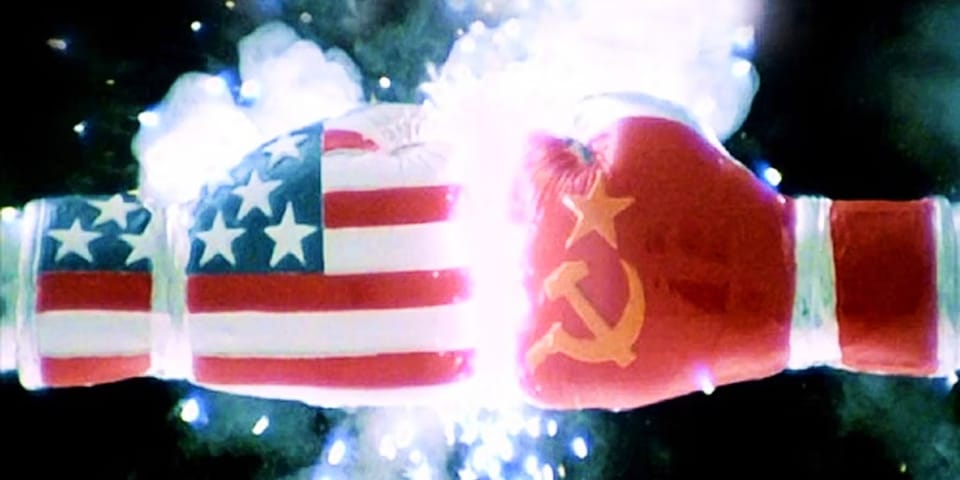Cultural Stasis Produces Fewer Cheesy Relics like Rocky IV

The much-maligned 1985 boxing film provides a few hints about the causes of 21st century artistic stagnation: namely, popular artists now work in a risk-averse creative paradigm that avoids making instantly-outmoded artworks
Sylvester Stallone’s 1985 film Rocky IV is so infamously schlocky that it’s become a cliché to even discuss its flaws. The Cold War Russia-versus-America plot is cartoonish, and Stallone’s direction is thoroughly over-the-top, from the opening sequence with exploding American and Russian flag boxing gloves to the superfluous montage sequences of pre-existing footage meant to stretch the film to feature length. Compared to other cinematic masterpieces, Rocky IV is not a well-made film, and no one has ever thought it to be. In his contemporaneous review, Roger Ebert called it “a film so predictable that viewing it is like watching one of those old sitcoms where the characters never change and the same situations turn up again and again.”
But unlike most bad films made in 1985, Rocky IV remains fascinating nearly forty years later. It has great value to us in 2024 as a relic — an artwork that embodies the unique stylistic choices of a particular point in time. Rocky IV is a time-traveling passport to 1985: the Manichaean Reaganite politics, the sassy robot maid, the soundtrack of power ballads and cold digital synths, the artless action-film editing and over-use of freeze-frame fade-outs, the casual lack of verisimilitude in using Wyoming as a stand-in for the Russian countryside.
There can be good relics, of course. Nothing represents the artistic decisions of 1967 better than Sgt. Pepper’s Lonely Hearts Club Band, and until recently, it was long canonized as the best album of all time. By comparison, almost all of Rocky IV’s bold aesthetic choices quickly soured. Just five years later, movies no longer looked or sounded like Rocky IV, and the end of the Cold War calmed the American spiritual anxiety powering its ridiculous plot. “Eye of the Tiger” became a joke. So did Carl Weathers. And in the last few decades, we’ve seen so many parodies of Eighties montage sequences that it is nearly impossible to watch the originals as earnest filmmaking. The musical montage in the middle of Rocky IV, where Stallone remembers clips from the previous Rocky films, is absolutely ludicrous.
Watching Rocky IV in 2024, however, was clarifying to me in the ongoing debate around "21st century cultural stasis." The basic argument is that culture is less healthy because there are fewer significant aesthetic changes. This implies a healthy ecosystem produces a large quantity of relics, as new styles outmode old ones. Songs that are "so Eighties" imply that the Nineties rejected all of those artistic choices. In the logic of the stasis narrative, if The Bourne Identity doesn’t scream 2002 with the same volume as Rocky IV screams 1985, culture must be slowing down.
Of course, the 21st century produced many now-outmoded looks: “early 2000s gel-spike-hair guy,” “2012-era pork pie hat speakeasy bartender,” “background extra in Legally Blonde.” At the same time, 2003's “Hey Ya” and "Drop It Like It's Hot" feel timeless rather than ludicrous. The 21st century seems to produce fewer novel aesthetics that humiliate the previous attempt at novel aesthetics.
Debates about the causes of 21st century cultural stasis always begin by blaming the economy and technology: monopolistic control of the media industry, the hollowing out of the middle class, rising health care costs, algorithmic feeds, the proliferation of media-making tools, etc. These are certainly legitimate factors and set the horizon for our social activity. Yet Rocky IV makes it clear that stasis also must involve how artists think about production. In 1985, Stallone made most choices as director that broke with pre-Eighties filmmaking techniques, and unfortunately for him, very few of these radical decisions became conventional in the future. He swung, and he missed. Compare that with original Rocky director John G. Avildsen who chose to do his film as a grainy, naturalistic underdog story. Both are products of their times, but the original is canonical, while part four is famous as the world's most dated film.
But Stallone was doing what a lot of 20th century artists felt was their core responsibility: pursuing bold aesthetics. He operated from a vague avant-garde mindset of wanting to make something that felt au courant. A major part of cultural stasis, then, may stem from most artists refusing to embrace contemporary aesthetic choices. In fact, I would argue that the Nineties ushered in a paradigm of rationalized, naturalistic aesthetics anchored in the meta-knowledge that artworks have a longer shelf life when they feel “real” and avoid mannerist/over-indulgent faddish aesthetics.
Technology and economy do play an indirect role in this change, but there seem to be three values guiding the anti-relic school of art:
1. A Rejection of Radical Stylization
In many cultures, art is expected to involve mannerism. Even today older Japanese audiences expect and enjoy “overacting." For maybe the last century, however, Western acting has instead emphasized acting that attempts to recreate real-life human expression.
This second approach itself is an aesthetic — not the lack of aesthetics. As Susan Sontag wrote in her 1965 essay “On Style,” “There is no neutral, absolutely transparent style.” Hemingway’s bare prose, for example, is its own style. Sontag complained in her day that “Today styles do not develop slowly and succeed each other gradually, over long periods of time which allow the audience for art to assimilate fully the principles of repetition on which the work of art is built; but instead succeed one another so rapidly as to seem to give their audiences no breathing space to prepare.” And perhaps as a backlash to this failure of new aesthetics to stick in the postmodern era, there was a move to naturalism — an attempt to find a common universal artistic language. This meant fewer obvious breaks with the past — and with the future. Alternative music in the 1990s stripped down production back to basic live instrumentation, making it sound like 1970s rock and teenage garage bands. Same goes for fiction: Most contemporary fiction avoids the overly stylized prose of a Woolf, a Gaddis, or a Pynchon, thereby making it seem era-less.
In clothing, the overall de-formalization of society led to a similar outcome. Men in suits gave the suit industry a literal canvas to direct sequential changes in silhouette, lapel sizes, and jacket lengths. This created clear chronological differences in looks. In a world where the baseline is T-shirts and shorts and the brands/graphics are primary over silhouettes, there is less opportunity for subtle stylizations that mark the eras. A Supreme T-shirt in 1998 doesn't look that different than a Supreme T-shirt in 2024.
2. Rationalization of Techniques
The cultural industry has always had a core business problem of not being able to anticipate demand for its products. The more these companies can reduce risk, the more they can profit. One way to mitigate risk is to collect audience data and try to create goods that better respond to human psychology. This has produced formulas and templates that increase the odds of success. Streaming TV episodes, for example, mostly end with small cliffhangers so that audiences will click to watch the next one episode immediately.
This kind of rationalization crowds out the possibility of idiosyncratic choices that can be made by a single auteur (and then sour). Moreover most big-budget films and albums are no longer made by a single person. Big studio productions — especially those made with computer graphics — require massive bureaucratic planning and technocratic decision making. Larger staff numbers are likely to pull the work towards an “average” approach based on time-held conventions.
3. A Deeper Respect for Pre-Existing Audience Tastes
Avant-garde art bombarded the audience with aesthetic choices that made them uncomfortable. More naturalistic art avoids this by conforming to the audience's conventional understanding of artistic forms. Everyone knows that a woman singing with an acoustic guitar is "music"; aleatoric composition on a prepared piano requires the audience to work harder.
Whether meant for market maximization or as a sign of respect for the audience, 21st century artists seem more interested in speaking their fans’ pre-existing aesthetic languages rather than pushing them into new styles. This results in the use of more classic artistic techniques. Simon Reynolds’ idea of “retromania” now makes sense as an audience-pleasing strategy. And the more that things pull directly from canonized past artworks, the less they’re likely to end up as embarassing relics. Janelle Monae’s “Tightrope” today sounds like a take on Sixties soul rather than “so 2010.”
That being said, the overuse of a particular retro sound can become associated with a specific contemporary era. Robin Thicke’s “Blurred Lines” so resembled a Marvin Gaye song that royalties now go to his estate. But as that song became de-canonized, it's now starting to sound “very 2013.” Same for “Uptown Funk” being “very 2014.” Yet I’d still argue that “Blurred Lines” is much weaker as a relic than Rocky IV, which is solely "1985."

The question is simply: are artists themselves choosing to reduce aesthetic risk-taking in their art? In an era where past and present songs all exist on the same Spotify playlist, few musical artists would want to create songs that may be ridiculed as passé a few years later. And all artists have the historical knowledge that helps them avoid mistakes of the past like Rocky IV. But this result — a lack of embarrassing relics — is what makes us feel that culture is less healthy. New genres like trap and drill feel vibrant because they outmoded "boom bap," yet it's this vibrancy that puts them at risk of feeling dated in the future. When artists stick with the classics, it's good for stabilizing their careers. But if they don't push for outrageously now sounds, we're left with the feeling of stagnation.
